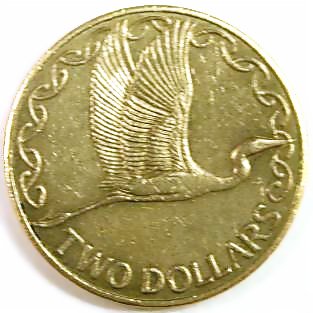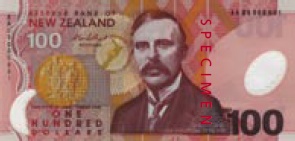|


The New Zealand dollar (sign: $; code: NZD) is the currency of New Zealand. It also circulates in the Cook Islands (see also Cook Islands dollar), Niue, Tokelau, and the Pitcairn Islands. It is divided into 100 cents.
It is normally written with the dollar sign $, or NZ$ to distinguish it from other dollar-denominated currencies. It is often informally known as the "Kiwi," kiwi typically being associated with New Zealand, and the $1 coin depicts a kiwi. It is one of the 12 most-traded currencies in the world.
History
The New Zealand dollar was introduced on 10 July 1967 when New Zealand decimalised its currency. The dollar replaced the New Zealand pound, which had been distinct from the pound sterling since 1933, at a rate of two dollars to one pound (10 shillings to a dollar).
The NZ$ was initially pegged to the US dollar at US$1.39 = NZ$1. This rate changed on 21 November of the same year to US$1.12 = NZ$1 after the devaluation of the British pound (see Bretton Woods system), although New Zealand devalued more than the UK.
In 1971 the US devalued its dollar relative to gold, leading New Zealand on 23 December to peg its dollar at US$1.216 with a 4.5% fluctuation range, keeping the same gold value. From 9 July 1973 to 4 March 1985 the dollar's value was determined from a trade-weighted basket of currencies.
The NZD was floated on 4 March 1985 at the initial rate of US$0.4444. Since then the dollar's value has been determined by the financial markets, and has been in the range of about US$0.39 to 0.82.
The dollar's post-float minimum average daily value was US$0.3922 on 22 November 2000, and it set a post-float maximum on 27 February 2008 of US$0.8213. Much of this medium-term variation in the exchange rate has been attributed to differences in interest rates.
The New Zealand dollar's value is often strongly affected by currency trading,and is among the 12 most-traded currencies.
On 11 June 2007 the Reserve Bank sold an unknown amount of New Zealand dollars in an attempt to drive down its value. This is the first intervention in the markets by the Bank since the float in 1985.
Two suspected interventions followed, but they were not as successful as the first: the first appeared to be initially effective, with the dollar dropping to approximately US$0.7490 from near US$0.7620. However, within little more than a month it had risen to new post-float highs, reaching US$0.8103 on 23 July 2007.
After reaching its post-float record high in early 2008, the value of the NZD plummeted throughout much of the 2nd half of 2008 and the first quarter of 2009 as a response to the global economic downturn and flight by investors away from 'riskier' currencies such as the NZD. The NZD bottomed out at approximately US$0.50 on March 6, 2009.However, it rebounded strongly as the year progressed, reaching the US$0.75 range by November 2009.
Half Pounds
In adopting the dollar, New Zealand followed the pattern of South Africa, and Australia in that when it adopted the decimal system, it decided to use the half pound unit as opposed to the pound unit of account. The choice of the name dollar was motivated by the fact that the reduced value of the new unit corresponded more closely to the value of the US dollar than it did to the pound sterling.
Coins
History
In 1967, coins were introduced for 1c, 2c, 5c, 10c, 20c and 50c denominations. The 1c and 2c coins were bronze, the others cupro-nickel.To ease transition, the 5c, 10c and 20c were the same size as the sixpence, shilling and florin that they respectively relaced. Until 1970 the 10c coin bore the additional legend "One Shilling". The obverse designs of all the coins featured Arnold Machin's portrait of Elizabeth II, with the legend ELIZABETH II NEW ZEALAND [date]. The reverse sides of coins introduced in 1967 did not follow the designs that were originally intended for them. Those modern art and sculpture themed designs were leaked to a newspaper and met a very negative public reaction. The final releases were given more conservative designs in line with public expectations.
In 1986, New Zealand adopted Raphael Maklouf's new portrait of the Queen. The 1c and 2c coins were last minted for circulation in 1987, with collector coins being made for 1988. The coins were demonetised on 30 April 1990.The lack of 1c and 2c coins meant that cash transactions were normally rounded to the nearest 5c (10c from 2006), a process known as Swedish rounding.
On 11 February 1991, aluminium-bronze $1 and $2 coins were introduced to replace existing $1 and $2 notes.In 1999, Ian Rank-Broadley's portrait of the Queen was introduced and the legend rearranged to read NEW ZEALAND ELIZABETH II.
On 11 November 2004 the Reserve Bank announced that it proposed to take the 5c coin out of circulation and to make the 50c, 20c and 10c coins smaller and use plated steel to make them lighter. After a three-month public submission period that ended on 4 February 2005, the Reserve Bank announced on 31 March that it would go ahead with the proposed changes. The changeover period started on 31 July 2006, with the old coins usable until 31 October 2006.The old 50c, 20c, 10c and 5c pieces are now no longer legal tender, but are still redeemable at the Reserve Bank. Prior to the change over these coins were similar, save for the legend and reverse artwork, to international (mainly Commonwealth) coins of the same British-derived sizes, which led to coins from other currencies, particularly older coins, being accepted by vending machines and many retailers.
Current circulating coins
New Zealand coinage is notable because the smallest unit of currency in circulation in New Zealand is the 10 cent piece, which along with the half krone coins of the Danish krone and Norwegian krone is one of the highest-valued bottom denomination coins in the world. As of 29 September 2009, the New Zealand 10 cent piece is valued at around 7 U.S. cents, 5 British pence and 5 Euro cents. All of these currencies have unit coins. The New Zealand 10 cent piece is worth 8 Australian cents-more than their lowest-value coin, the 5 cent piece.
The value of the bottom denomination coin is rarely used as a measure of the strength of a currency.
All New Zealand coins have IRB written underneath the Queen's head. JB is on the 10cent beside the koruru tongue, the 50cent in front of the endeavour and on the old 5 cent piece next to the tuataras tail.
Banknotes
In 1967, notes were introduced in denominations of $1, $2, $5, $10, $20 and $100, with all except the $5 replacing their pound predecessors. The original series of dollar notes featured a portrait of the Queen on the obverse, while the reveres featured native birds and plants. The notes were changes slightly in 1981 due to a change of printer - the most noticeable difference being the portrait of the Queen, whom had been updated and now was facing forward, not to the left. The $50 note was added in 1983 to fill the long gap between the $20 and the $100 notes. $1 and $2 notes were discontinued in 1991 after being replaced with coins.
A new series of notes was introduced in 1992. The obverse of each note featured a notable New Zealander, while the reverse featured a native New Zealand bird and New Zealand scenery. In 1999, polymer notes replaced the existing paper notes. The designs remained much the same, but were changed slightly to accommodate new security features, with the most obvious changes being the two tranparent windows.
History of NZD foreign exchange rates
With the breakdown of the Bretton Woods system in 1971, both Australia and NZ converted the mostly-fixed foreign exchange regimes to a moving peg against the US dollar.
In September 1974, Australia moved to a peg against a basket of currencies called the trade weighted index (TWI) in an effort to reduce fluctuations associated with its peg to the US dollar.
The peg to the TWI was changed to a moving peg in November 1976, causing the actual value of the peg to be periodically adjusted.
Since the late 1990s, and certainly since the end of the Cold War the US dollar has had less and less overall influence over the value of both the NZD and AUD against other currencies.
The text on this page has been made available under the Creative Commons Attribution-ShareAlike License and Creative Commons Licenses
| 